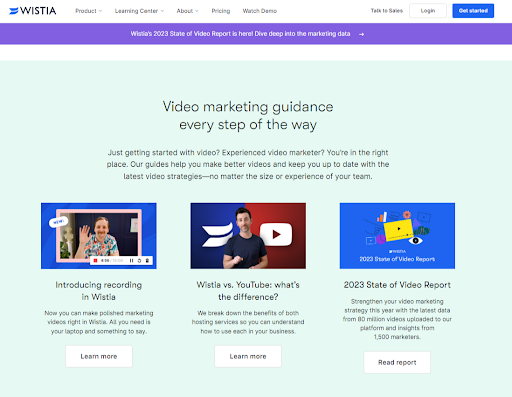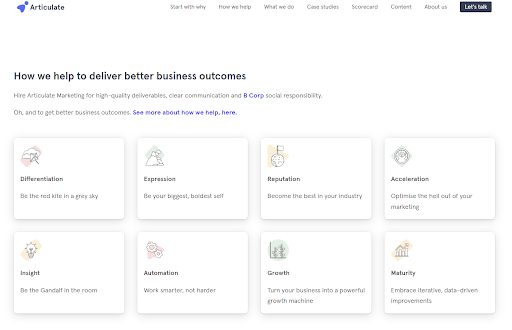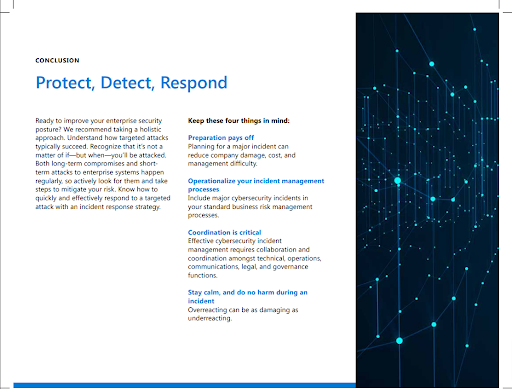But as soon as it comes to selling a B2B product, most brands still default to a strictly business and nothing-short-of-robotic delivery. 🤖
B2C marketing has always relied on emotion. Marketers fearlessly play on the funny, tug at the heartstrings, turn on the nostalgia.
But B2B buyers are people too.
And wherever people are involved, you can bet they’re relying on their feelings to help them make big purchasing decisions. If you’re looking to build a deeper connection with your audience, here are a few B2B-friendly ways to get emotional in your marketing.
Emotive messaging for B2B buyers
- Take time to empathize
- Trade sunshine-and-rainbows for cautious optimism
- Swap fear-based language for calm confidence
B2B buyers have feelings too: 3 better ways to connect
95% of purchasing decisions are said to be based on subconscious feelings — not rational thoughts.
If you and your competitor satisfy your prospect’s needs equally, it’s the emotional connection (or lack thereof) that will most likely sway the deal.
But using emotion in B2B messaging isn’t just about sprinkling a little humor into your brand awareness campaigns.
Here are some effective ways to use empathy, optimism, and confidence in your B2B messaging and put your brand in position #1 on the vendor shortlist.
1. Take time to empathize
It’s not that easy to circumvent your gut instinct when something just feels right. Empathy-driven messaging shows potential customers that unlike those other guys — you get them.
But according to experts like Ardath Albee, CEO & B2B Marketing Strategist at Marketing Interactions, that also means brands need to “Stop talking about their damn products.”
If you want your prospects to feel seen, you’ve got to commit to prioritizing their needs — not your own.
Here are some tips to help make your messaging more empathetic:
- Acknowledge the position your customer is in
At the copy level, this can involve using certain phrases. For example, “Picking the right product is never easy,” or “Never again experience an X-related setback.” For all you copywriting nerds out there, think “U” (Understand) in the QUEST framework.
- Use case studies
Be clear about your customers’ problems, how you solved them, and the hard and “soft” outcomes that came from your experience working together. And don’t be afraid to go into specifics. The goal is to hit the sweet spot of, “If it worked for them, it can work for me.”
- Put your prospect first, product second
No matter how evolved your marketing team, this one bears repeating. From your social media to your blog, podcast, newsletter and website — your content needs to speak directly to your reader. For copywriters, that means using second-person point of view, with clear, specific, and context-driven examples to paint a clear picture for the reader.
Content spotlight: Wistia ✨
Wistia gets that while the world may be obsessed with video, not everyone’s ready to film a pro-level YouTube Short on their iPhone. They take time to empathize with their B2B audience with highly relatable lines like: “Just getting started with video? Experienced video marketer? You’re in the right place.”
From there, they gently guide prospects towards context-driven resources on how to use their product.
 Source: https://wistia.com/
Source: https://wistia.com/
2. Scrap the sunshine-and-rainbows and aim for cautious optimism
Negative words trigger the amygdala, the brain’s fear center, which can add to the stress of making a large purchase.
But that doesn’t mean an everything-is-sunshine approach is the only way to go. B2B prospects are burnt out on content and more skeptical than ever. They’ve been through a market shift or two and know that, in the world of business, there is no such thing as smooth sailing.
Forget the rainbows and unicorns and use a little cautious optimism to acknowledge your audience’s concern, before introducing possible solutions or insights about how things can improve.
Here are some ways to instill a sense of optimism in your B2B content:
- Create an inspiring atmosphere
Use facts, figures, and real stories from business history to illustrate resilience. This can be especially helpful when your brand is focused on… well, the not so happy side of things. For example, antivirus software providers or insurance companies. It can be hard to put a positive spin on messaging when your entire business has to do with damage control, but with clear examples and insights proving this too shall pass, you can help your reader reclaim their hope for the future.
- Avoid false promises
These days, nobody’s buying into the whole “We guarantee your success!” promise. Instead, go back to those hard results in your case studies and spell out the wins you can actually prove. As usual, you’re looking for anything that touches, time, energy, or the holy budget: “Increase your ROI by X percent,” “Save X hours everyday,” “Achieve [desirable outcome] within X days.”
Content spotlight: Articulate Marketing ✨
Articulate Marketing nails an optimistic tone with their homepage copy. “Nothing is too complicated,” they say, “Except love and time machines.”
A common fear among B2B prospects, especially those who dwell in the wild world of marketing, is the feeling that no one else’s business problem is as complicated/nuanced/impossible-to-manage/fill-in-the-blank as theirs.
Articulate’s Better Business Outcomes cards are built on positive messaging that meets the reader where they are, no matter what goal they’re facing — and it’s pretty inspirational stuff. After all, if they’re optimistic about helping you hit your marketing goals, why shouldn’t you be too?  Source: https://www.articulatemarketing.com/
Source: https://www.articulatemarketing.com/
3. Replace fear-based language with a sense of calm confidence
Fear-based marketing is as old as time. And your prospects have seen it way too many times.
Why not take this negative emotion and turn it on its head? Replace fear-based language with a sense of calm confidence when addressing the problems your prospect is facing.
Customers are often bombarded with information, but few brands take the time to engage in sense-making and change-enablement for prospects.
Sense-making involves understanding the vast amount of information out there and helping customers make sense of how it can fit in with their needs. Which details matter most to them? Which aspect have they not considered before? What should they be thinking about?
Change-enablement empowers prospects to understand the mechanics of switching to a new vendor or service provider. Which products can be integrated seamlessly into their current workflow? What will the timeline look like? Do they get to keep the workflows they already use and love?
Both sense-making and change-enablement can significantly reduce the stress of having to figure it all out on your own, helping you build trust with prospects long before you meet in person.
Here’s how you can write copy that leaves your reader feeling confident:
- Use knowledge to build confidence
The more your prospect understands your product, the more confident they feel about buying it. At the line level, this could mean using a copywriting framework like FAB (Features, Advantages, Benefits) to quickly communicate everything your reader needs to know — what your product does, why they should consider it, and what’s in it for them if they do.
- Be transparent about what your product can do
Make the decision-making process easier by laying out your product’s pros with full transparency. Of course, this doesn’t mean you have to offer every feature imaginable, but it does mean that you’ll need to take extra care to explain why you offer certain features, how you manage your product roadmap, and the specific customizations and integrations that can help them meet their goals.
- Address your prospect’s fears at every touchpoint
Most buyers go through 27 information-gathering interactions when assessing a product, yet more than 50% of potential B2B deals don’t go through. Your messaging needs to be consistent across formats and channels, including clear language about the exact problems you’re solving.
Fear-based emotive content spotlight: Anatomy of a Breach ✨
Microsoft’s ebook is a great example of turning fear-based messaging on its head by providing clear numbers and practical tips to help prospects feel confident handling a super scary situation — the dreaded data breach.
They take sense-making to a whole other level by making a fearful situation feel doable.  Source
Source
Create content that connects
Emotions matter — even in B2B content.
Whether you’re crafting the concept for your next webinar series or revamping your product pages, it pays to remember that B2B buyers are people too. Like all of us, they make decisions based on a variety of factors — including how they feel.
So get to know your audience’s emotional needs. Use storytelling, emotional triggers, and the right words in the right place to make your content connect.
Arya Dixit is a freelance B2B/B2C copywriter, creative writer, and editor obsessed with slipping in a little humor between words (a terrible habit, really). She enjoys connecting with people and brands to craft narratives that are unique, valuable and impactful. She lives in Pittsburgh and devours General Tso’s tofu every chance she gets.
